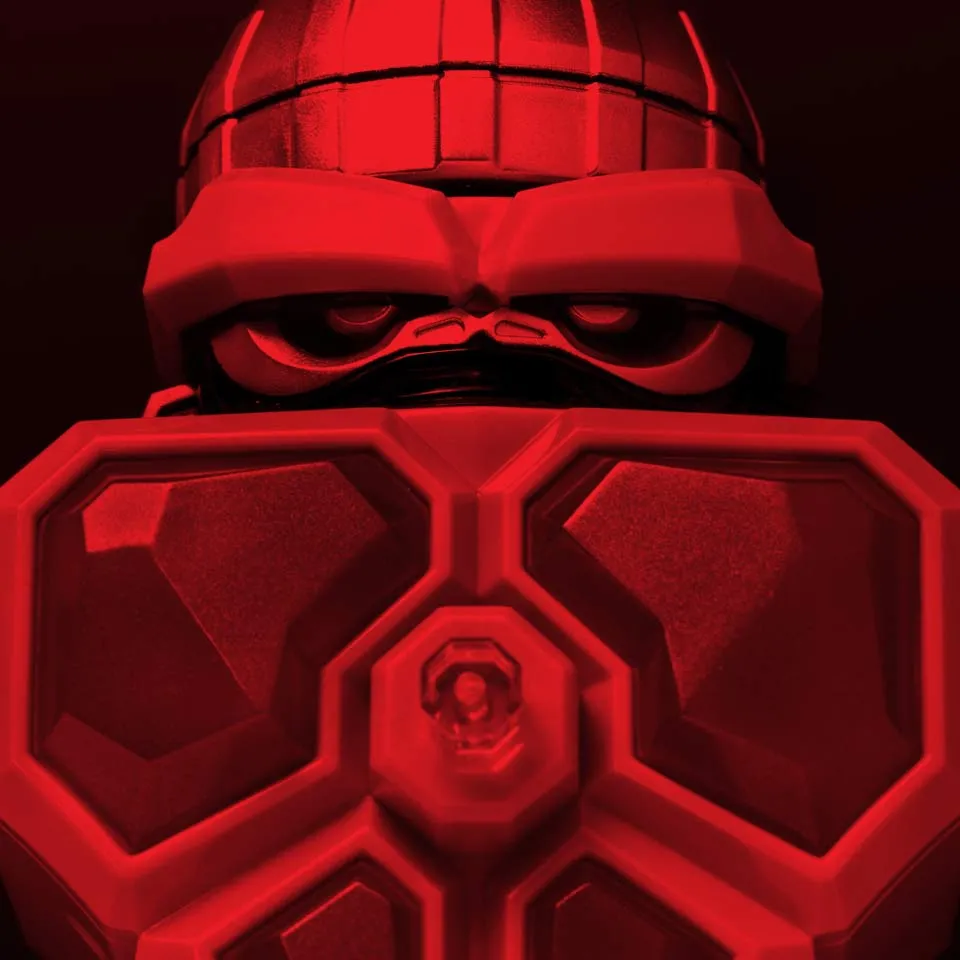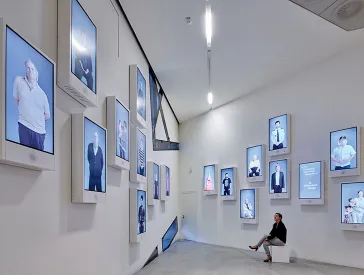Bringing the Film Set To Life
Article in the Exhibition Catalogue GOLEM
Anna-Carolin Augustin
Gables extend upwards, enclosed by a fortified wall with threateningly sharp crenellations. In the background a fairytale-like castle rises up on a hill. These motifs, conceived and created by Hans Poelzig and Marlene Moeschke, are the focal point of the sketches of the now iconic set design for the silent film The Golem: How He Came into the World.
The film’s director and leading actor, Paul Wegener, was able to recruit the architect Hans Poelzig for the Golem film project, who in turn wrote an enthusiastic letter appealing to his colleague, sculptor Marlene Moeschke to get involved: “Something can be made of this in any case, I think something magnificent and phantasmagorical. But you have to help me.”1
And Marlene Moeschke helped. While Poelzig supplied the ideas for the architecture of the exterior themes, Moeschke created interior designs, props, and costumes for the film and later also built the film set. In addition to numerous sketches by Poelzig on single sheets of paper and in notebooks, a Golem sketchbook of Marlene Moeschke is also extant. The expressiveness and choice of motifs in the drawings by the two artists are very similar, revealing their close collaboration. This is apparent in particular in Moeschke’s sketches for the Imperial Hall (Kaisersaal): She copied the form of the rising flames, which Poelzig used for the gables, in a neo-Gothic stylized interior of dynamic, pointed arches with richly ornamented pinnacles. It was not by chance that she juxtaposed the drawing of a Gothic pointed arch with the sketch of a tree with large roots and curved branches, as Marlene Moeschke—like Hans Poelzig—was very much inspired by the organic forms of living nature. The expressive, anthropomorphic formal language employed in Poelzig and Moeschke’s set design challenged established visual conventions. However, they corresponded to the effective force and modernity of the then innovative medium of film. Also, the set seemed alive, taking up the theme of animation and thus a central element of the golem legend itself. Poelzig and Moeschke might have been inspired by Gustav Meyrink’s popular golem novel, in which the author described the “spectral communion” of the houses in the Jewish ghetto of Prague, the “true masters of the street,” which come alive in the night.
The synthesis of various artistic domains in designing sets for theater and film productions opened a chance for Poelzig and Moeschke to achieve their ideal of a “Gesamtkunstwerk.” The fusion of handicrafts and visual arts in this area corresponded to the principles of modern currents in the applied arts, as represented by the German Werkbund, an association of architects, artists, and builders of which Poelzig was on the executive committee since 1919. Through the virtually absolute artistic freedom in film, which offered space for utopian fantastical designs, the young film industry had a special appeal as a modern testing ground. It is thus hardly surprising that both Poelzig and Moeschke were enthusiastic about the film medium and even forged plans with Paul Wegener to set up an architectural design workshop with its own film studio. Although the artists, who married in 1923, never worked on another comparably successful film project after that, their film set design for the golem film was a fundamental innovation. The three-dimensional film set that actors could actually enter and stand upon justified claims to be an autonomous work of art. This contributed to Paul Wegener’s third golem silent film becoming a classic in the history of film.
Historian Anna-Carolin Augustin interned as research associate at the Jewish Museum Berlin and is presently a curatorial assistant for the Golem exhibition.
Translated by Allison Brown
- Letter from a private estate, Hamburg; cited in Heike Hambrock, Hans and Marlene Poelzig − Bauen im Geist des Barock: Architekturphantasien, Theaterprojekte und moderner Festbau (1916–1926) (Delmenhorst and Berlin: Aschenbeck & Holstein Verlag, 2005), 71 ↩︎
Sketchbook for The Golem: How He Came into the World Marlene Moeschke-Poelzig, Berlin, c. 1920 Pencil drawings, 21.1 x 13.8 cm Deutsches Filminstitut, Frankfurt a.M./Nachlass Hans Poelzig – Dauerleihgabe der Adolf und Luisa Haeuser-Stiftung für Kunst- und Kulturpflege
Citation recommendation:
Anna-Carolin Augustin (2016), Bringing the Film Set To Life. Article in the Exhibition Catalogue GOLEM.
URL: www.jmberlin.de/en/node/4702

Online Edition of the GOLEM Catalog: Table of Contents
The Golem in Berlin: Introduction by Peter Schäfer
Chapter 1
- The Golem Lives On: Introduction by Martina Lüdicke
- My Light is Your Life: Text by Anna Dorothea Ludewig
- Avatars: Text by Louisa Hall
- The Secret of the Cyborgs: Text by Caspar Battegay
Chapter 2
- Jewish Mysticism: Introduction by Emily D. Bilski
- Golem Magic: Text by Martina Lüdicke
- Golem, Language, Dada: Text by Emily D. Bilski
Chapter 3
- Transformation: Introduction by Emily D. Bilski
- Jana Sterbak’s Golem: Objects as Sensations: Text by Rita Kersting
- Crisálidas (Chrysalises): Text by Jorge Gil
- Rituals: Text by Christopher Lyon
- A Golem that Ended Well: Text by Emily D. Bilski
- On the Golem: Text by David Musgrave
- Louise Fishman’s Paint Golem: Text by Emily D. Bilski
Chapter 4
- Legendary Prague: Introduction by Martina Lüdicke
- Golem Variations: Text by Peter Schäfer
- Rabbi Loew’s Well-Deserved Bath: Text by Harold Gabriel Weisz Carrington
Chapter 5
- Horror and Magic: Introduction by Martina Lüdicke
- Golem and a Little Girl: Text by Helene Wecker
- The Golem with a Group of Children Dancing: Text by Karin Harrasser
- Current page: Bringing the Film Set To Life: Text by Anna-Carolin Augustin
- Golem and Mirjam: Text by Cathy S. Gelbin
Chapter 6
- Out of Control: Introduction by Emily D. Bilski
- Golem—Man Awakened with Glowing Hammer: Text by Arno Pařík
- Dangerous Symbols: Text by Charlotta Kotik
- Be Careful What You Wish For: Text by Marc Estrin
Chapter 7
- Doppelgänger: Introduction by Martina Lüdicke
- From the Golem-Talmud: Text by Joshua Cohen
- Kitaj’s Art Golem: Text by Tracy Bartley
- The Golem as Techno-Imagination?: Text by Cosima Wagner
See also
- GOLEM: 2016, online edition with selected texts of the exhibition catalog
- GOLEM: 2016, complete printed edition of the exhibition catalog, in German
- Golem. From Mysticism to Minecraft: Online Feature, 2016
- GOLEM: Exhibition, 23 Sep 2016 to 29 Jan 2017
